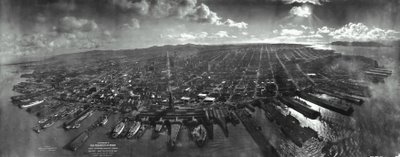
Click here for this beautiful high res photo.
The San Francisco earthquake of 1906 was a major earthquake that struck San Francisco and the coast of northern California at 5:12am on Wednesday, April 18, 1906. The most widely accepted magnitude for the earthquake is a moment magnitude (Mw) 7.8; however, other values have been proposed from 7.7 to as high as 8.3. The mainshock epicenter occurred offshore about 2 miles (3 km) from the city. It ruptured along the San Andreas Fault both northward and southward for a total length of 296 miles (477 km). Shaking was felt from Oregon to Los Angeles, and inland as far as central Nevada. The earthquake and resulting fire would be remembered as one of the worst natural disasters in the history of the United States, comparable in devastation to the Galveston Hurricane of 1900 and Hurricane Katrina in 2005.
 At the time, only 567 deaths were reported; the figure was concocted by government officials who felt that reporting the true death toll would hurt real estate prices and efforts to rebuild the city. Also, hundreds of casualties in Chinatown went ignored and unrecorded due to racism at the time. Today, this figure has been revised to a conservative estimate of at least 13,000, though some estimates have put it as high as 27,000 deaths. Most of the deaths occurred in San Francisco itself, but 189 were reported elsewhere across the San Francisco Bay Area. Other places in the Bay Area such as Santa Rosa, San Jose, and Stanford University also suffered severe damage. Between 225,000 and 300,000 people were left homeless out of a population of about 410,000; half of the refugees fled across the bay to Oakland. Newspapers at the time described Golden Gate Park, the Presidio, the Panhandle, and the beaches between Ingleside and North Beach being covered with makeshift tents.
At the time, only 567 deaths were reported; the figure was concocted by government officials who felt that reporting the true death toll would hurt real estate prices and efforts to rebuild the city. Also, hundreds of casualties in Chinatown went ignored and unrecorded due to racism at the time. Today, this figure has been revised to a conservative estimate of at least 13,000, though some estimates have put it as high as 27,000 deaths. Most of the deaths occurred in San Francisco itself, but 189 were reported elsewhere across the San Francisco Bay Area. Other places in the Bay Area such as Santa Rosa, San Jose, and Stanford University also suffered severe damage. Between 225,000 and 300,000 people were left homeless out of a population of about 410,000; half of the refugees fled across the bay to Oakland. Newspapers at the time described Golden Gate Park, the Presidio, the Panhandle, and the beaches between Ingleside and North Beach being covered with makeshift tents.
 The earthquake and fire would leave a long-standing and significant impression on the development of California. At the time of the disaster, San Francisco had been the ninth-largest city in the United States and the largest on the West Coast, with a population of about 410,000. Over a period of 60 years, the city had become the financial, trade and cultural center of the West; operated the busiest port on the West Coast; and was the "gateway to the Pacific", through which growing US economic and military power was projected into the Pacific and Asia. Over 80% of the city was destroyed by the earthquake and fire. Though San Francisco would rebuild quickly, the disaster would divert trade, industry and population growth south to Los Angeles, which during the 20th century would become the largest and most important urban area in the West. However, the 1908 Lawson Report, a study of the 1906 quake, showed that the very same San Andreas Fault which had caused the disaster in San Francisco ran close to Los Angeles as well.
The earthquake and fire would leave a long-standing and significant impression on the development of California. At the time of the disaster, San Francisco had been the ninth-largest city in the United States and the largest on the West Coast, with a population of about 410,000. Over a period of 60 years, the city had become the financial, trade and cultural center of the West; operated the busiest port on the West Coast; and was the "gateway to the Pacific", through which growing US economic and military power was projected into the Pacific and Asia. Over 80% of the city was destroyed by the earthquake and fire. Though San Francisco would rebuild quickly, the disaster would divert trade, industry and population growth south to Los Angeles, which during the 20th century would become the largest and most important urban area in the West. However, the 1908 Lawson Report, a study of the 1906 quake, showed that the very same San Andreas Fault which had caused the disaster in San Francisco ran close to Los Angeles as well.  The earthquake was the first natural disaster of its magnitude to be documented by photography and motion picture footage. Furthermore, it occurred at a time when the science of seismology was blossoming. The overall cost of the damage from the earthquake was estimated at the time to be around $400 million.
The earthquake was the first natural disaster of its magnitude to be documented by photography and motion picture footage. Furthermore, it occurred at a time when the science of seismology was blossoming. The overall cost of the damage from the earthquake was estimated at the time to be around $400 million.

